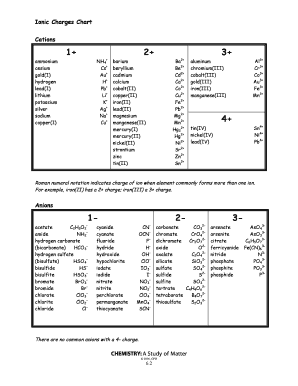
Ionic Charges Chart Form


What is the Ionic Charges Chart
The ionic charges chart is a visual representation that outlines the charges of various ions, which are atoms or molecules that have gained or lost electrons. This chart is essential for understanding chemical reactions, as it helps predict how different elements will interact based on their charge. It typically includes common ions, their symbols, and their corresponding charges, making it a valuable tool for students and professionals in chemistry.
How to Use the Ionic Charges Chart
Using the ionic charges chart involves identifying the ions relevant to your chemical equation or reaction. Start by locating the element on the chart, which will indicate its charge. For example, sodium (Na) typically has a charge of +1, while chloride (Cl) has a charge of -1. Understanding these charges allows you to balance chemical equations accurately and predict the formation of compounds.
Steps to Complete the Ionic Charges Chart
Completing the ionic charges chart requires careful attention to detail. Begin by listing the elements you are studying. Next, determine the common oxidation states for each element, which can usually be found in textbooks or reliable online resources. Finally, compile this information into a clear format, ensuring that each ion's symbol and charge are accurately represented. This completed chart can serve as a quick reference for future chemical calculations.
Legal Use of the Ionic Charges Chart
The ionic charges chart is legally utilized in educational settings and laboratories to ensure accurate chemical analysis and reporting. When used in scientific publications or educational materials, it is crucial to cite the source of the chart if it is not original work. Adhering to proper citation practices not only maintains academic integrity but also complies with intellectual property laws.
Key Elements of the Ionic Charges Chart
Key elements of the ionic charges chart include the ion symbols, their corresponding charges, and sometimes the common names of the ions. Some charts may also indicate the state of the ions (solid, liquid, or gas) and their common compounds. Understanding these elements helps users quickly interpret the information and apply it to chemical equations or laboratory experiments.
Examples of Using the Ionic Charges Chart
Examples of using the ionic charges chart include balancing chemical equations and predicting the products of reactions. For instance, when combining sodium and chloride, the chart shows that sodium has a +1 charge and chloride has a -1 charge. This information indicates that they will combine in a one-to-one ratio to form sodium chloride (NaCl). Such examples demonstrate the practical applications of the chart in real-world chemistry scenarios.
Quick guide on how to complete ion chart
Complete ion chart effortlessly on any device
Online document management has become increasingly popular among businesses and individuals. It offers an excellent eco-friendly alternative to traditional printed and signed documents, as you can find the necessary form and securely keep it online. airSlate SignNow provides you with all the tools needed to create, modify, and electronically sign your documents quickly and without delays. Handle ion sheet on any platform with airSlate SignNow's Android or iOS applications and simplify any document-related task today.
The simplest method to modify and electronically sign ionic charge chart effortlessly
- Obtain ionic charges chart and click on Get Form to initiate.
- Utilize the tools we provide to fill out your form.
- Highlight signNow sections of your documents or conceal sensitive information with tools that airSlate SignNow offers specifically for that purpose.
- Create your signature using the Sign tool, which takes just a few seconds and carries the same legal validity as a conventional wet ink signature.
- Review the details and click on the Done button to save your modifications.
- Select how you wish to share your form, via email, SMS, or invitation link, or download it to your computer.
Eliminate the worry of lost or misplaced files, tedious form searching, or mistakes that necessitate creating new document copies. airSlate SignNow fulfills your requirements in document management with just a few clicks from any device of your choice. Edit and electronically sign ionic chart and ensure exceptional communication throughout your form preparation process with airSlate SignNow.
Create this form in 5 minutes or less
Related searches to ionic charge
Create this form in 5 minutes!
How to create an eSignature for the ionic charge sheet
How to create an electronic signature for a PDF online
How to create an electronic signature for a PDF in Google Chrome
How to create an e-signature for signing PDFs in Gmail
How to create an e-signature right from your smartphone
How to create an e-signature for a PDF on iOS
How to create an e-signature for a PDF on Android
People also ask ion charge sheet
-
What is an ion sheet and how does it work?
An ion sheet is a document format designed to facilitate electronic signatures and secure document sharing. It enables users to electronically sign documents in a seamless manner, ensuring that the integrity and authenticity of the document are maintained throughout the signing process. This innovative approach simplifies workflows for businesses, making it easier to handle important contracts and agreements.
-
What are the key features of the ion sheet?
The ion sheet comes equipped with numerous features, including real-time document tracking, customizable templates, and advanced security options. Users can easily manage their documents, track signers' progress, and receive notifications when documents are signed. These features not only streamline the signing process but also enhance overall document management efficiency.
-
How much does the ion sheet service cost?
The cost of using the ion sheet service varies depending on the selected plan and the number of users. airSlate SignNow offers flexible pricing options that cater to different business sizes and needs. Potential users can visit the pricing section on our website to find a comprehensive overview of the plans available and choose one that fits their budget.
-
What benefits does the ion sheet provide for businesses?
The ion sheet offers several benefits, including time savings, increased productivity, and enhanced customer satisfaction. Businesses can expedite the document signing process, allowing for quicker transactions and decision-making. Additionally, by adopting electronic signatures, companies can reduce paper usage and contribute to a more sustainable environment.
-
Can the ion sheet integrate with other software applications?
Yes, the ion sheet integrates seamlessly with various software applications, enabling users to enhance their workflow and productivity. Integration with popular tools like CRM systems and cloud storage applications ensures that users can manage their documents effectively across different platforms. This flexibility makes the ion sheet a valuable addition to any business's tech stack.
-
Is the ion sheet secure for sensitive documents?
Absolutely, the ion sheet prioritizes security by implementing top-notch encryption and authentication measures. Our platform ensures that all documents are securely stored and transmitted, protecting sensitive information from unauthorized access. Users can trust the ion sheet to maintain the confidentiality and integrity of their important documents.
-
How can I get started with the ion sheet?
Getting started with the ion sheet is easy! Simply sign up for an account on the airSlate SignNow website and follow the guided setup process to upload your documents. Once your account is set up, you can immediately begin using the ion sheet to send and eSign your documents efficiently.
Get more for ion charges
Find out other chart of charges
- Can I eSign Idaho Mutual non-disclosure agreement
- Help Me With eSign Kentucky Month-to-month rental agreement form
- eSign Nevada Month-to-month rental agreement Mobile
- eSign Nevada Month-to-month rental agreement Now
- How Can I eSign Kentucky Month-to-month rental agreement form
- eSign Nevada Month-to-month rental agreement Later
- eSign Nevada Month-to-month rental agreement Myself
- eSign Nevada Month-to-month rental agreement Free
- Can I eSign Kentucky Month-to-month rental agreement form
- eSign Nevada Month-to-month rental agreement Secure
- eSign Nevada Month-to-month rental agreement Fast
- eSign Nevada Month-to-month rental agreement Easy
- eSign Nevada Month-to-month rental agreement Simple
- eSign Nevada Month-to-month rental agreement Safe
- eSign Nebraska Month-to-month rental agreement Online
- eSign Illinois Mutual non-disclosure agreement Online
- eSign Nebraska Month-to-month rental agreement Computer
- How To eSign Nevada Month-to-month rental agreement
- eSign Illinois Mutual non-disclosure agreement Computer
- eSign Illinois Mutual non-disclosure agreement Mobile